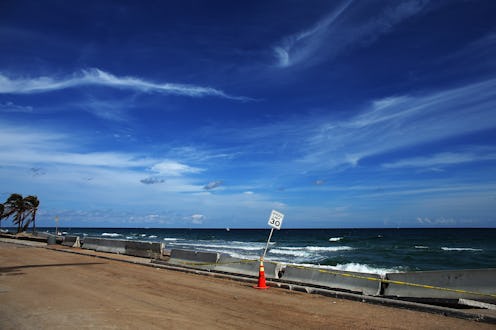News
Florida Is Unprepared For Rising Sea Levels
St. Augustine, Florida, the oldest permanently occupied city in the U.S., is slowly being buried by the sea. The city is one of close to 100 in Florida that is within a few feet of rising sea levels, which flood St. Augustine's streets about 10 times per year, according to the Associated Press. And, as of right now, there's no statewide plan to address rising sea levels along the Florida coast, so citizens are simply waiting for a response as the water inches closer.
Flooding of small city streets isn't the only problem associated with rising sea levels. Cities along the coast have also dealt with water wells being contaminated by seawater, higher tides have meant more frequent flooding of main roads from Jacksonville to Key West, and updates and repairs on old flood-control systems have become more expensive, according to the Sun Sentinel. Despite these measurable daily realities, the Republican Gov. Rick Scott hasn't introduced any kind of statewide plan to address or discuss climate change, according to the AP. During a brief interview when the AP in March, Scott said cities and counties should contact environmental and water agencies to find answers.
Unfortunately, the agencies he was talking about are state-funded, and Scott slashed funding for many of these agencies in 2011. Many of them, such as the South Florida Water Management District, oversee water restoration for important areas like the Everglades, according to the Sun Sentinel.
A Sad Rejection Of Science
The National Climate Assessment, released by the federal government last year, predicted a 5-degree temperature increase in Florida by 2100, a $40 billion loss in tourism revenue by the 2050s, and environmental effects such as increased flooding, according to The Atlantic. The assessment predicted that roads in Miami, Tampa, and Daytona Beach could be hit particularly hard by flooding, and most Florida officials have accepted that reality. Miami Mayor Philip Levine spoke to The New York Times about rising sea levels in the state:
Sea level rise is our reality in Miami Beach. We are past the point of debating the existence of climate change and are now focusing on adapting to current and future threats.
Further, a separate report released Thursday by the National Climate Assessment found that sea levels have risen eight inches since 1870 and are projected to rise one to four feet by the end of the century, according to the Times. In southeast Florida, specifically, waters could rise up to two feet by 2060, according to a report by the Southeast Florida Regional Climate Compact, cited by the Times.
The South Florida Water Management District oversees 2,000 miles of levees and 71 water-pumping stations that make up flood-control systems in South Florida, which can suffer flooding, water contamination, and wetland destruction if they aren't working properly, according to the Sun Sentinel. And district officials said they need to keep adding to the system to keep South Florida above water. But, of course, these additions will cost a lot of money.
Unfortunately, Scott cut the district's budget by 30 percent in 2011, which forced layoffs, delayed construction plans for new canals and water pumping stations, and left the district with $10 million less than what it usually gets to do its job, according to the Sun Sentinel. Statewide, an editorial by the Tampa Bay Times found that Scott reduced budgets for the state's five regional water management districts by $700 million while also appointing land developers and shipping executives to their dwindling boards.
Scott, an outspoken climate change critic, also allegedly banned the use of "climate change" and "global warming" in official state communications, according to a March report by the Florida Center for Investigative Reporting. Scott and other Florida officials have denied any policy officially banning the words, but countless state employees told FCIR that the rule is unspoken. Scott did not immediately respond to Bustle's request for comment. Engineer Reuben Franklin spoke to the AP about the state's reluctance to address the pressing problem:
Only when the frequency of flooding increases will people get nervous about it, and by then it will be too late. There's no guidance from the state or federal level. ... Everything I've found to help I've gotten by searching the Internet.
The Effects Of Ignoring Florida's Submersion
South Florida officials like the Miami mayor are trying to address sea level concerns, but the AP found that they're mostly going ignored. Six of eight drinking water wells in South Florida have been abandoned because of salt water contamination from flooding, when the water district managers asked the Florida's Department of Environmental Protection for help, all they got were a few conference calls, according to records obtained by the AP.
Southern Florida is home to $130 billion in real estate value, two nuclear power plants, 74 airports, and hundreds of public schools, according to a report by the Florida Oceans and Coastal Council, cited by TIME. The Everglades are also worth $80 billion alone in tourism revenue. Christina DeConcini, director of government affairs at the World Resources Institute, told TIME:
Southeast Florida is really ground zero on climate change and sea level rise in particular. There’s a disconnect there. It seems if you were an elected official in the state of Florida, it would be incumbent on you to protect your constituents.
For most of the towns in southern Florida where the sea overtakes roads during bad storms, ignoring the change isn't an option. Courtney Barker is the city manager of Satellite Beach, a town near Cape Canaveral that floods every time there's a heavy rainstorm. She said to the AP:
For us, it's a reality, it's not a political issue. When you have to listen to that mantra, 'Climate change, is it real or not?' you kind of chuckle, because you see it.
Images: Getty Images (3)
